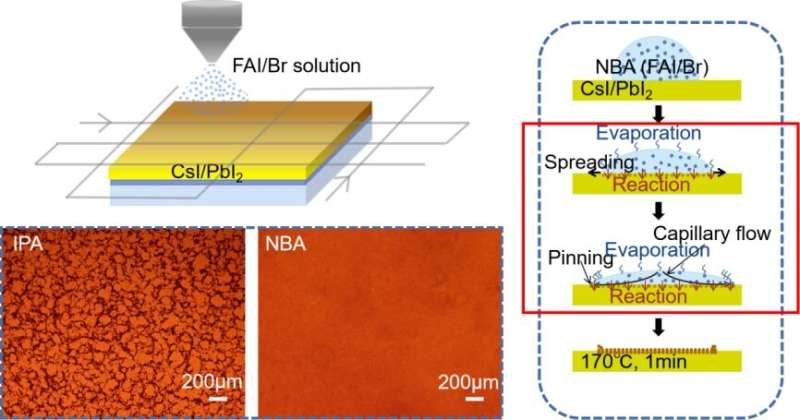Reaction-dependent coffee-ring-regulating method in spray-coating perovskite

When droplets containing non-volatile solutes dry on substrates, the fluid migrates outward via capillary force. Consequently, the solutes are carried to the periphery of the droplets and form "coffee rings" after drying. This is known as the coffee ring effect (CRE). The CRE is typically observed during printing, and it significantly affects the uniformity and quality of films, especially in droplet-based dispersed deposition methods, such as spray-coating.
Recently, spray-coating, which is a mature industrial method, has been widely used for the fabrication of perovskite solar cells (PSCs) owing to its high throughput, outstanding compatibility with diverse substrates, and good scalability. However, the CRE-induced inhomogeneity of the sprayed films leads to poor device reproducibility and limits the improvement in device performance. The power conversion efficiencies (PCEs) of sprayed PSCs are still significantly lower than those of their spin-coated counterparts. Therefore, CRE elimination is of significant practical interest for the development of spraying methods for PSCs.
Recently, Prof. Peng and colleagues at Wuhan University of Technology reported a reaction-dependent coffee-ring-regulating method. In most studies about CRE, the solution does not react with the substrate. However, in their study, the liquid droplets formamidinium iodide/formamidinium bromide (FAI/Br) reacted with the solid CsI/PbI2 films, which affected solute distribution. Therefore, the reaction process was regulated via solvent selection, and it was determined that solvents with adequate drying rates, such as n-butyl alcohol, can effectively suppress coffee ring formation. On one hand, an appropriate long drying time promoted droplets spreading and merging, and ultimately favored the integrated wet films formation, which decreased the "rings" counts . Conversely, during spreading, the reaction between FAI/Br and the CsI/PbI2 films hindered solute accumulation at droplet periphery, resulting in a uniform solute deposition. Lastly, dense, homogeneous, and highly uniform Cs0.19FA0.81PbI0.5Br2.5 perovskite films were prepared. Owing to the high quality of the perovskite films, the PCEs of the fabricated PSCs reached 19.17%, which was among the highest PCEs of spray-coated PSCs reported to date.
In this study, an effective approach for controlling the CRE of spraying methods to achieve high-performance PSCs was developed. Moreover, a new idea for the development of other printing technologies was proposed.
The study was published in the Journal of Energy Chemistry.
More information: Xinxin Yu et al, "Coffee ring" controlment in spray prepared >19% efficiency Cs0.19FA0.81PbI2.5Br0.5 perovskite solar cells, Journal of Energy Chemistry (2021). DOI: 10.1016/j.jechem.2021.09.032
Provided by Chinese Academy Sciences




















